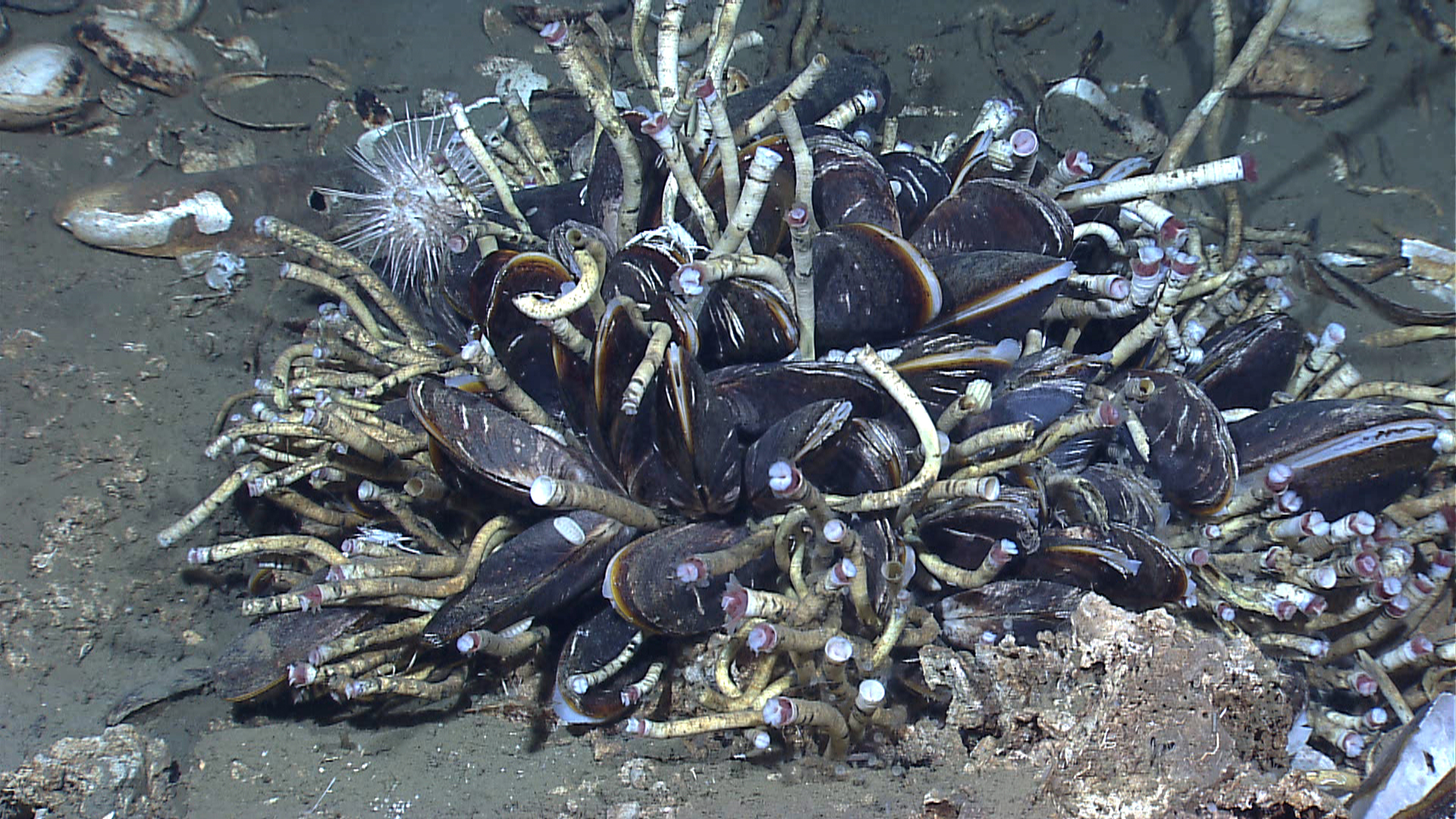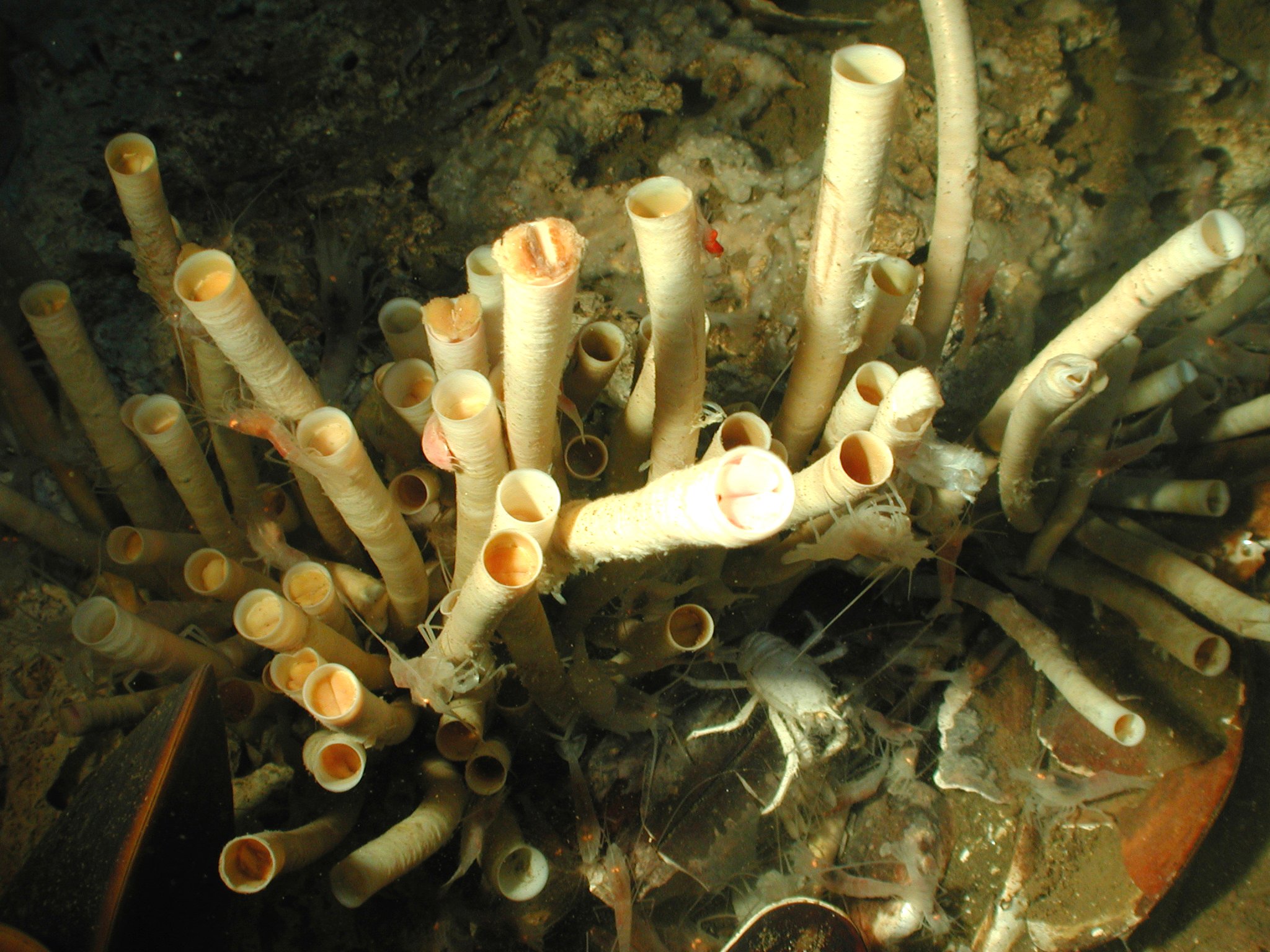
Distribution:
In deep water near hydrothermal vents along
mid-ocean ridges in the Pacific and Atlantic Oceans.
Cold seeps such as those found in the
Gulf of America also serve as habitat.
Ecosystem:
Biological communities near hydrothermal
vents and cold seeps
Feeding Habits:
Symbiotic Feeder
Taxonomy:
Families Siboglinidae
Class Polychaeta
Summary
Tubeworms are fast-growing deep-water invertebrates that anchor themselves to underwater surfaces near hydrothermal vents and cold seeps. Lacking a mouth, stomach, intestines, and eyes, tubeworms rely on a nutrient byproduct produced by the chemosynthetic bacteria that live in their bodies to survive.
Because deepwater habitats and the organisms that live there – including tubeworms – can potentially be impacted by unmitigated OCS activities, BOEM must continue to better understand these ecosystems and their sensitivity to various impact producing factors. Research efforts to map, explore, and categorize deepwater benthic environments have significantly advanced BOEM’s knowledge of continental margin geology, the types of seafloor communities, and connectivity with mid-water organisms.
Overview and Physical Characteristics
Tubeworms are elongated deep-sea invertebrates that anchor themselves to underwater surfaces near nutrient-rich environments such as hydrothermal vents and cold seeps. Once attached, they secrete chitin, which hardens to form a protective tube around their bodies – similar to an insect’s exoskeleton. These worms can sometimes grow over 8 feet in length; as they grow, they continue to secrete chitin, extending the tube. Tubeworms lack a digestive system and rely on symbiotic bacteria housed in an organ – called a trophosome – within their bodies for nourishment. These bacteria are chemosynthetic, oxidizing hydrogen sulfide and hydrocarbons to produce energy. This process creates organic compounds that the tubeworms consume as food.
Habitat and Distribution
Tubeworms are primarily found in deep-sea environments near hydrothermal vents, cold seeps, and other areas containing the ingredients for the chemosynthetic process. For example, cold seeps in the Gulf release methane and other hydrocarbons that support tubeworm populations. The Juan de Fuca Ridge, an underwater volcanic ridge off the coast of Washington and Oregon, contains hydrothermal vent systems where tubeworms thrive. Tubeworms also inhabit Monterey Canyon, off the coast of central California, where many hydrocarbon cold seeps are located.
Ecosystem
Tubeworms live at extreme ocean depths, ranging from 2,000 to 3,000 meters (about 6,500 to 10,000 feet). Both hot and cold temperatures can be found at these depths, depending on the habitat. Some species live near hydrothermal vents along mid-ocean ridges where tectonic plates are spreading apart, with temperatures exceeding over 300°C (572°F). Others inhabit cold seep environments where hydrocarbons leak from the ocean floor, with temperatures close to 0°C (32°F). Due to their depths, both environments are subject to extremely high pressure, making them inhospitable for most sea creatures. Being well-adapted to the hot and cold extremes and relying on the nutrients their symbiotic bacteria produce for energy allow tubeworms to thrive in both habitats.
Feeding Habits
The bacteria in the tubeworm’s trophosome oxidize various chemicals found in hydrothermal vents and cold seeps to generate energy. The byproducts of this chemosynthetic process are sugars and other nutrients, which the tubeworm absorbs directly from the bacteria.
Behavior and Reproduction
Tubeworms spend most of their lives anchored in one spot, near the specialized environments that provides the necessary chemical resources for survival. They reproduce through external fertilization, releasing sperm and eggs into the water. Fertilization occurs in the water column; once fertilized, the eggs develop into free-swimming larvae. These larvae eventually settle on a suitable surface and grow into adult worms.
Visual System and Communication
Tubeworms do not have eyes, so they do not have a visual system. Tubeworms also lack complex nervous systems and do not exhibit any behavior that could be considered communication. However, they are highly sensitive to changes in temperature, chemical composition, and pressure in their extreme deep-sea habitats, and will withdraw into their protective tubes to avoid predators and unfavorable water conditions.
Conservation Status
Tubeworms have not been designated with a conservation status. But their deep-sea habitats may be indirectly affected by human activities such as deep-sea mining, fishing, and climate change. Hydrothermal vent ecosystems in which tubeworms live are unique and diverse and are part of a number of marine protected areas.
Fun Fact
Tubeworms are capable of remarkable growth rates and are some of the fastest-growing marine invertebrates. In nutrient-rich environments such as hydrothermal vents, some species of tubeworms have been observed to grow up to 33 inches per year.
BOEM Studies:
Deepwater Atlantic Habitats II: Continued Atlantic Research and Exploration in Deepwater Ecosystems with Focus on Coral, Canyon, and Seep Communities (Deep SEARCH)
Through its mapping and exploration activities, the Deep SEARCH study yielded the first known observation of vestimentiferan (giant) tubeworms in the Southeast Atlantic.
Comparison of Environmental Effects from Different Offshore Wind Turbine Foundations
This study examines the potential effects offshore wind foundations can have on marine ecosystems, including changes to deepwater habitats and associated ecological communities where tubeworms are found.
Facilitating Interagency Partnerships in Support of Ocean Mapping, Exploration, and Characterization
BOEM continues to study the distribution, composition, and sensitivity of deepwater seafloor habitats (i.e., hard bottoms, cold seeps, hydrothermal vents) and their associated benthic communities in support of the interagency National Strategy for Mapping, Exploring, and Characterizing the U.S. EEZ.
This story is part of the “Unleashing the Science” series, showcasing how bureaus within the Department of the Interior produce and apply science to ensure responsible management decisions for our planet now and for the future.
--BOEM--
The Department of the Interior’s Bureau of Ocean Energy Management (BOEM) manages development of U.S. Outer Continental Shelf (OCS) energy, mineral, and geological resources in an environmentally and economically responsible way.



